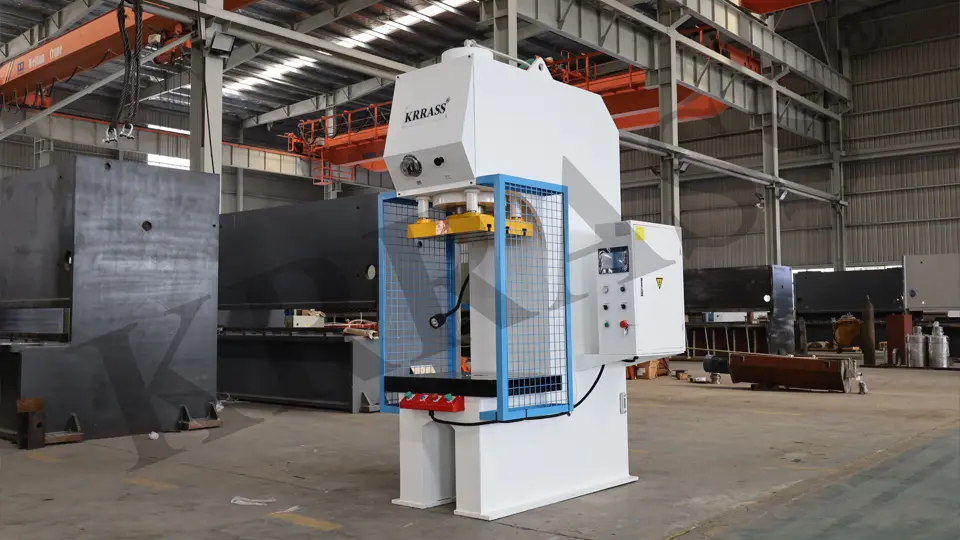In this comprehensive article, we will unravel the science behind this incredible machine, explaining what a hydraulic press is, its core components, and its myriad applications. As a leading hydraulic press manufacturer, we take you behind the scenes to offer insights you won't find anywhere else.
- What is hydraulic press
- The Core Components of a Hydraulic Press
- The Hydraulic Cylinder: Where the Magic Happens
- The Pump: Powering the System
- The Control Panel: Command Central
- The Principle Behind Hydraulic Presses
- Real-world Examples of Pascal's Principle
- How a Hydraulic Press Works: Step-by-step Explanation
- How is a hydraulic press different from a mechanical press?
- Types of Hydraulic Presses
- Choosing the Right Type for Your Needs
- Common Applications of Hydraulic Presses
- Specialized Uses
- Environmental Considerations
- Troubleshooting and Maintenance
What is a Hydraulic Press?
Ah, the hydraulic press. If you've ever been captivated by a video of a watermelon getting squashed or a piece of metal being effortlessly bent, you've probably already met this machine. But what exactly is a hydraulic press?
A hydraulic press is a machine that uses a hydraulic cylinder to generate a compressive force. By using the hydraulic equivalent of a mechanical lever, it amplifies smaller forces into a larger, more potent force. Yes, it's as powerful as it sounds, and it's a cornerstone in various industries.
Picture this: You've got a cylinder, and inside that cylinder is a piston. The piston moves up and down due to the pressurized hydraulic oil (or some other fluid) that's pumped into the cylinder. That's the basic mechanic! Think of it as a strongman that doesn't need to catch its breath; it just keeps exerting that relentless pressure.
So, why does it matter? In essence, the hydraulic press is a game-changer for businesses. Whether you're a hydraulic press manufacturer or a business owner looking for a custom hydraulic press solution, the versatility of this machine cannot be overstated.
To give you an idea of its ubiquity, hydraulic presses are used in everything from car repair shops to the aeronautics industry. These presses can shape metal, assemble parts, and even crush cars into recyclable cubes. Now, that's what we call versatility!
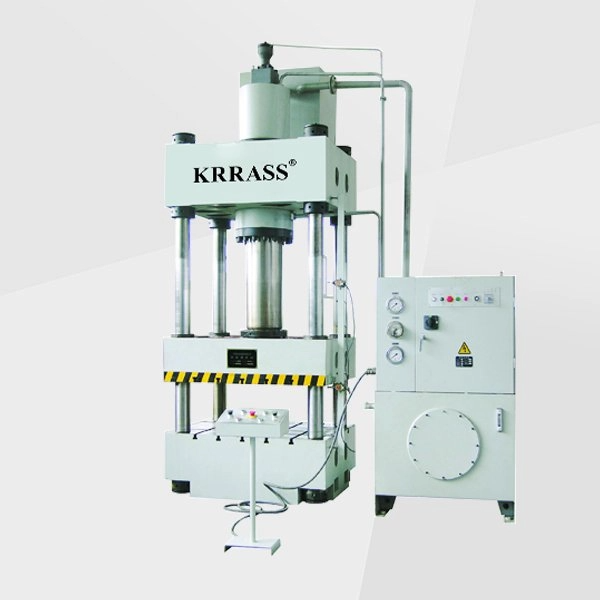
The Core Components of a Hydraulic Press
Before we delve deeper into how a hydraulic press operates or the various applications it serves, it's crucial to understand its core components. Think of these as the vital organs that make this impressive machine function seamlessly.
Hydraulic Cylinder
The hydraulic cylinder is essentially the heart of the hydraulic press machine. This is where the hydraulic fluid is pumped to generate the force that makes the press do its job. The cylinder consists of a piston which moves up and down, exerting the required pressure on the material placed in the press.
Pump
Think of the pump as the circulatory system of the hydraulic press. It's responsible for moving the hydraulic fluid through the machine. The pump ensures that the fluid reaches the cylinder at the appropriate pressure, enabling the piston to move and thus generate force.
Base
The base serves as the foundation of the hydraulic press machine. It's the skeleton that holds everything together, ensuring the machine remains stable during operations. After all, you wouldn't want a machine that exerts immense pressure to be unstable, would you?
Control Panel
The control panel is the brain of the operation. It's where you control the settings, adjust the pressure, and essentially command the hydraulic press machine to do your bidding. Modern control panels often come with touch-screen interfaces and can be programmed for automated tasks.
Worktables
Last but not least, we have the worktables. This is where the action happens. The worktables are specifically designed to handle various materials and sizes. Depending on the nature of your project, you may need worktables with special features like temperature control or adjustable heights.
The Hydraulic Cylinder: Where the Magic Happens
The hydraulic cylinder is the showstopper of a hydraulic press machine. It's the part where, as the title suggests, the magic truly happens. Let's dig into its significance and different types.
The Role of the Hydraulic Cylinder in Force Multiplication
Have you ever wondered how a hydraulic press can crush a car like it's a mere soda can? The secret lies in the hydraulic cylinder's ability for force multiplication. Essentially, the hydraulic cylinder leverages fluid pressure to turn a small amount of input force into a mammoth amount of output force. It's similar to how a pulley system can make lifting a heavy weight seem easy. The hydraulic cylinder performs this Herculean task with precision and consistency, making it invaluable in numerous applications.
Different Types of Cylinders: Single-Acting vs. Double-Acting
If you're in the market for a hydraulic press, or perhaps you're a hydraulic press manufacturer yourself, you'll find it beneficial to know that not all hydraulic cylinders are created equal. The two main types are single-acting and double-acting cylinders.
A single-acting cylinder relies on fluid pressure to move in one direction, usually extending the piston. The piston then retracts via an external force, such as a spring. Think of it like a one-way street; it's good for tasks requiring force in a single direction.
On the other hand, a double-acting cylinder uses hydraulic pressure for both extending and retracting the piston. It's like a two-way street, offering greater control and efficiency, especially for tasks that require force to be applied in multiple directions.
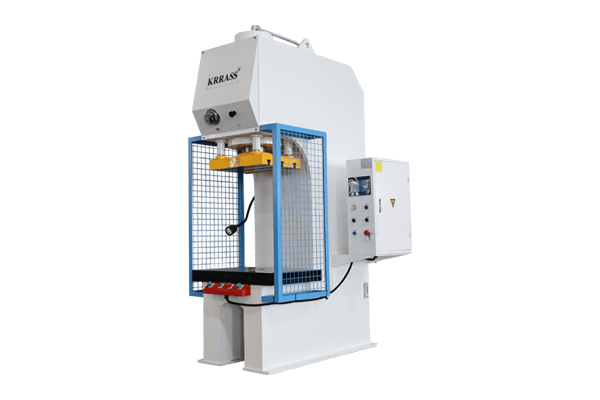
The Pump: Powering the System
While the hydraulic cylinder may be the heart of a hydraulic press machine, the pump is its lifeblood. Without it, the entire system would come to a screeching halt. So, what makes the pump so crucial? Let’s explore.
How the Pump Moves Fluid
The pump is essentially the circulatory system of the hydraulic press. It's responsible for moving hydraulic fluid from the reservoir to the hydraulic cylinders, and often back again. This movement creates the pressure differential needed for the hydraulic cylinder to function. Imagine you're using a water gun; you need to pump it to make the water squirt out with force. The hydraulic pump works on a similar principle, but at an industrial scale. Its continuous operation ensures that the hydraulic cylinder gets the pressurized fluid it needs to execute tasks flawlessly.
Types of Hydraulic Pumps: Gear Pump, Piston Pump, Vane Pump
If you're a hydraulic press manufacturer, an engineer, or even a savvy consumer, you might be interested to know that there are different types of hydraulic pumps. These variations serve different needs and applications, so it's vital to choose wisely.
The gear pump is the simplest and most common type. It uses gears to push fluid from one side to the other. It's reliable, but not as efficient as some other types.
The piston pump, on the other hand, utilizes multiple pistons to move the fluid. It offers higher pressure and efficiency, making it a good fit for more demanding applications.
Lastly, the vane pump uses vanes inside a rotating chamber to move the fluid. These pumps are known for their low noise levels and are often used in quieter environments.
The choice of pump can significantly impact the performance and efficiency of your hydraulic press. Knowing the differences can help you make an informed decision that aligns with your needs and the requirements of your specific applications.
The Control Panel: Command Central
The control panel is the brain of the hydraulic press machine. Much like a pilot needs a cockpit to fly a plane, operators require a user-friendly and efficient control panel to command the hydraulic press. But what makes a control panel stand out, especially when safety is a concern? Let's dissect its key features.
How Controls Are Managed
Operating a hydraulic press isn't as simple as pushing a button. The control panel is a sophisticated interface that manages various operations, from setting the force of the hydraulic cylinder to controlling the speed and direction of the pump. Think of it as the dashboard of a car: you have controls for speed, direction, and even air conditioning, all designed for a safe and efficient ride. Similarly, a well-designed control panel ensures that operators have full command over the hydraulic press, making the workflow seamless and efficient.
Importance of Safety Features
Safety is not an afterthought; it's a necessity. When you're dealing with a machine as powerful as a hydraulic press, the importance of safety features cannot be overstated. A top-notch control panel comes equipped with emergency stop buttons, overload protection, and even features like pressure relief valves. These safety measures are much like the seatbelt and airbags in a car—features you hope never to use but are grateful for when needed.
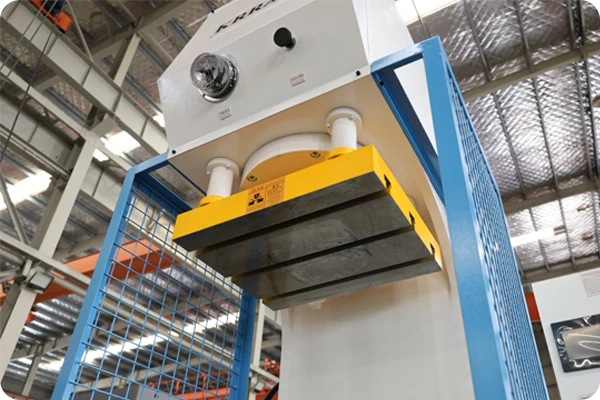
The Principle Behind Hydraulic Presses
Many of us marvel at the sheer power of a hydraulic press machine but may not fully understand the underlying principle that makes it work. So, what's the scientific secret sauce behind these powerful machines? The answer lies in Pascal's Principle. Let's unpack it.
Explanation of Pascal's Principle
Pascal's Principle, named after the French mathematician Blaise Pascal, is the cornerstone of hydraulic systems. The principle states that in a confined fluid at rest, any change in pressure applied at any point in the fluid is transmitted undiminished in all directions. In layman's terms, if you apply pressure to a confined fluid, that pressure will be felt equally throughout the entire fluid. This is the reason a small amount of force applied to a hydraulic press can yield a much larger force on the other end.
Real-world Examples of Pascal's Principle
Pascal's Principle isn't just a theoretical concept confined to the realm of physics textbooks. It has concrete applications that affect our daily lives, especially in car braking systems and hydraulics in airplanes. Let's explore how this powerful principle shapes these real-world systems.
Car Braking Systems
Ever wondered how a light press on your car's brake pedal can bring tons of metal to a halt? You can thank Pascal's Principle for that. In a hydraulic braking system, when you press the brake pedal, you exert force on a small piston. This force is then transmitted through brake fluid to larger pistons on each wheel, effectively amplifying the force and bringing the vehicle to a stop. If it weren't for Pascal's Principle, you'd need the leg strength of a superhero to stop a speeding car!
Hydraulics in Airplanes
Airplanes are another fascinating application of hydraulic systems, again thanks to Pascal's Principle. From controlling the flaps to the landing gear, hydraulic systems are vital. Take the landing gear, for example. When the pilot activates the system, hydraulic fluid transfers pressure from a small piston to larger ones, lowering or raising the landing gear. This efficient force multiplication ensures that even the heaviest of aircraft can have a smooth and safe landing.
Whether it's the hydraulic press manufacturer applying Pascal's Principle in industrial machines, or engineers incorporating it into automotive and aviation designs, this principle plays a pivotal role in technology that shapes our world.
How a Hydraulic Press Works: Step-by-step Explanation
So, you've heard about the principles and components that make a hydraulic press tick. But how does all this theoretical knowledge translate into action? Let's take a walk-through, step by step, on how a hydraulic press works, focusing on the journey of hydraulic fluid and the multiplication of force.
The Journey of Hydraulic Fluid
It all begins with the hydraulic fluid, usually oil, housed in a reservoir. Once the control panel activates the pump, this fluid is sucked into the hydraulic system. The pump then pressurizes the fluid, propelling it through tubes into the hydraulic cylinder.
Inside the cylinder, the pressurized fluid acts upon a piston, generating movement and force. After the operation is completed, the fluid flows back into the reservoir, making it a closed-loop system.
How Force is Multiplied
Remember Pascal's Principle? Here it comes into play. The force exerted on the smaller piston is multiplied as it moves through the system. The fluid takes this smaller force and applies it across a larger area, represented by the larger piston in the hydraulic cylinder. As a result, a small force applied at one end becomes a much larger force at the other, allowing the hydraulic press to lift or crush heavy objects with relative ease.
How is a Hydraulic Press Different from a Mechanical Press?
When it comes to industrial machinery for shaping materials, you might encounter a fork in the road: should you go for a hydraulic press or a mechanical press? Though they share the common goal of transforming material through pressure, the mechanisms driving these two types of presses are quite different. Below, we'll dissect these differences to help you decide which press suits your needs best.
Power Source and Mechanism
A hydraulic press uses fluid pressure to generate force, while a mechanical press relies on mechanical linkages and a flywheel to produce force. This makes the hydraulic press more versatile in terms of the type of work it can perform, thanks to its fluid power system. On the other hand, a mechanical press is often faster but less versatile.
Force and Speed Control
In a hydraulic press, you can easily control the force and speed, usually through a control panel, offering greater flexibility for complex tasks. Mechanical presses have a set speed and force that is difficult to modify, making them less adaptable but more straightforward for repetitive tasks.
Safety Features
Most hydraulic presses come with built-in safety features, given the volatile nature of working with pressurized fluid. Mechanical presses, while also incorporating safety features, often require additional external mechanisms to ensure safe operation.
Types of Hydraulic Presses
One of the first things you'll notice when diving into the world of hydraulic presses is the sheer variety available. Whether you're a seasoned manufacturer or a hobbyist, choosing the right type of hydraulic press can be pivotal for your project's success. Let's take a closer look at some popular types.
Benchtop Presses
Benchtop presses are compact and designed to fit on a workbench. They are ideal for smaller-scale operations and are usually manually operated. Despite their size, they pack a punch and offer a great deal of accuracy for detailed work.
C-Frame Presses
The C-Frame Press gets its name from its C-shaped frame, which allows for easier access to the die area. These presses are often used in applications requiring higher precision and are usually electrically operated. They are excellent for assembly, straightening, and other specialized tasks.
Arbor Presses
Arbor presses are primarily used for pressing together or removing machine parts. They're ideal for tasks that don't require a high level of force, such as riveting, installing, or removing bearings.
H-Frame Presses
H-Frame Presses are more rugged and versatile, often used in industrial settings for heavy-duty tasks. The design offers better stability and can handle a broad range of applications, from metal forming to car repair.
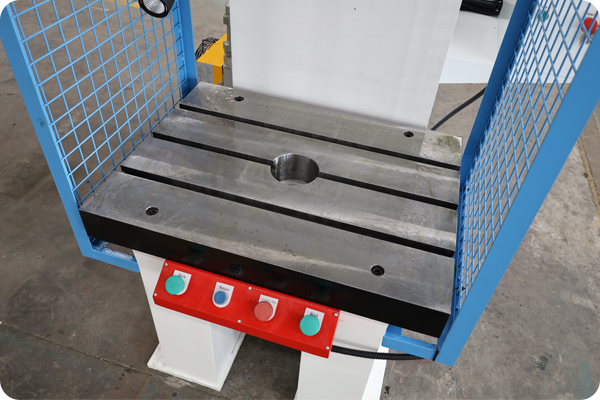
Choosing the Right Type for Your Needs
So you've learned about the core components, the science, and even the different types of hydraulic presses available on the market. But how do you decide which one is the perfect fit for you? The key to making an informed decision lies in understanding your specific needs and how they align with the features of various hydraulic presses.
Identifying Your Requirements
Before you even start window-shopping, sit down and make a list of your needs. What materials will you be working with? What are the dimensions of your workspace? Do you require a press for professional manufacturing or for smaller projects?
Consulting with a Hydraulic Press Manufacturer
Once you have a clear idea of your requirements, the next step is to consult with a reputable hydraulic press manufacturer. They can provide insights into which machine would be most suitable for your application.
Examining the Specifications
Always check the technical specifications of the hydraulic press. This includes the force capacity, stroke length, and size. These details will help you determine if the press is capable of handling your intended tasks.
Evaluating Additional Features
Many hydraulic presses come with additional features like programmable logic controllers (PLCs), advanced safety features, and customizable worktables. While these may increase the initial cost, they can offer long-term benefits.
Common Applications of Hydraulic Presses
Hydraulic presses aren't just confined to one sector or application. In fact, they are such versatile machines that you'll find them in numerous industries, doing a myriad of tasks. Let's look at some of the most common sectors where hydraulic presses are making a significant impact.
Metalworking
In the metalworking industry, hydraulic presses are indispensable. They are commonly used for tasks like stamping, bending, and forging metal sheets and parts. These machines offer the precision and force required to shape metals into desired forms, all while ensuring high levels of efficiency and quality.
Plastic and Rubber Molding
When it comes to molding plastic and rubber, the hydraulic press is your go-to machine. Its controlled pressure and temperature settings make it ideal for molding complex parts with high-quality finishes. From everyday products like bottles and containers to specialized components, hydraulic presses make it possible.
Automotive Industry
In the automotive sector, hydraulic presses are commonly used for forming and assembling various parts, from body panels to internal components like gears. The automotive industry values the speed, accuracy, and reliability that hydraulic presses offer, making these machines a critical part of automotive manufacturing processes.
Specialized Uses
While hydraulic presses are a common sight in metalworking shops and automotive factories, their versatility doesn't end there. You might be surprised to know that these powerhouses also have unique applications in the food industry and the medical field. Let's dig deeper.
In the Food Industry: Juice Extraction
Ever wondered how tons of fruits are turned into juice in a matter of hours? Hydraulic presses are commonly employed in the food industry for the extraction of juices from fruits like apples, oranges, and grapes. They offer a high level of efficiency and are capable of extracting more juice compared to traditional methods, all while maintaining the quality and nutritional value.
In the Medical Field: Pill Making
Hydraulic presses also find their way into the medical industry, particularly in the manufacturing of pills and tablets. The consistent force applied by the press ensures that each pill has the same amount of active ingredients and excipients, thereby maintaining a uniform dosage. This level of precision is crucial in the medical field, where even slight variations can have significant implications.
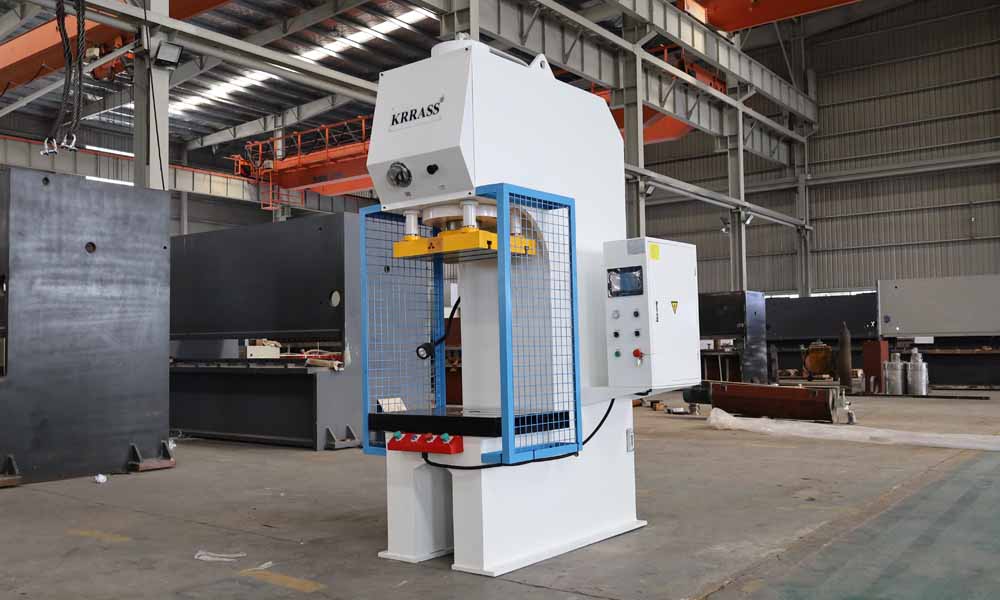
Environmental Considerations
While hydraulic presses are known for their robustness and versatility, it's also critical to examine their environmental footprint. As stewards of the planet, both manufacturers and users have responsibilities to ensure these machines operate in the most eco-friendly manner possible. Let's explore two major areas of concern: energy efficiency and hydraulic fluid disposal.
Energy Efficiency
It's not just about doing the job well; it's also about doing it efficiently. Modern hydraulic presses are designed with energy conservation in mind, using variable speed drives and programmable logic controllers to minimize energy consumption. The key is to use only as much force as needed for the task, reducing wasteful expenditure of energy.
Hydraulic Fluid Disposal
The hydraulic fluid that powers the press is another environmental consideration. Proper disposal methods must be followed to prevent soil and water contamination. Used hydraulic fluid should never be poured down drains or disposed of in regular trash. Many service providers specialize in the safe and eco-friendly disposal of used hydraulic fluids, turning potential waste into reusable resources.
Troubleshooting and Maintenance
Hydraulic presses are robust, but they're not invincible. Like any machinery, they require a regimen of care and attention to operate efficiently over the long term. Knowing how to troubleshoot common issues and conduct preventive maintenance can save you both time and money. Let's get into the nitty-gritty.
Common Issues and Solutions
From leaks to unexpected noise, hydraulic presses can experience a variety of issues. One common problem is the loss of pressure. If your hydraulic press machine is not exerting enough force, it might be due to a worn-out seal or pump. Replacing these parts usually solves the issue. Another problem could be overheating, often remedied by cleaning the hydraulic fluid filters to ensure smooth flow.
Maintenance Tips for Longevity
Regular maintenance is the key to prolonging the lifespan of your hydraulic press. Always keep the hydraulic fluid clean and at optimal levels. This involves regular checks and fluid changes, just like you'd do for your car's engine oil. Moreover, periodic inspections for any wear and tear in the mechanical parts can help you catch issues before they escalate.
In conclusion, a well-maintained hydraulic press is a productive one. As a leading hydraulic press manufacturer, we offer comprehensive after-sales service and maintenance packages to ensure your machine stays in top condition. Trust us; a little care goes a long way!
Conclusion: The Power of the Press
We've walked you through the intricacies of hydraulic presses, from the fundamental principles to their diverse applications. This guide has everything you need to know, whether you're in the automotive industry, metalworking, or even the medical field. If you're looking for the most reliable hydraulic press machines, look no further than Krrass, the go-to manufacturer for quality and innovation. Explore our website today for more information!
Read More:
